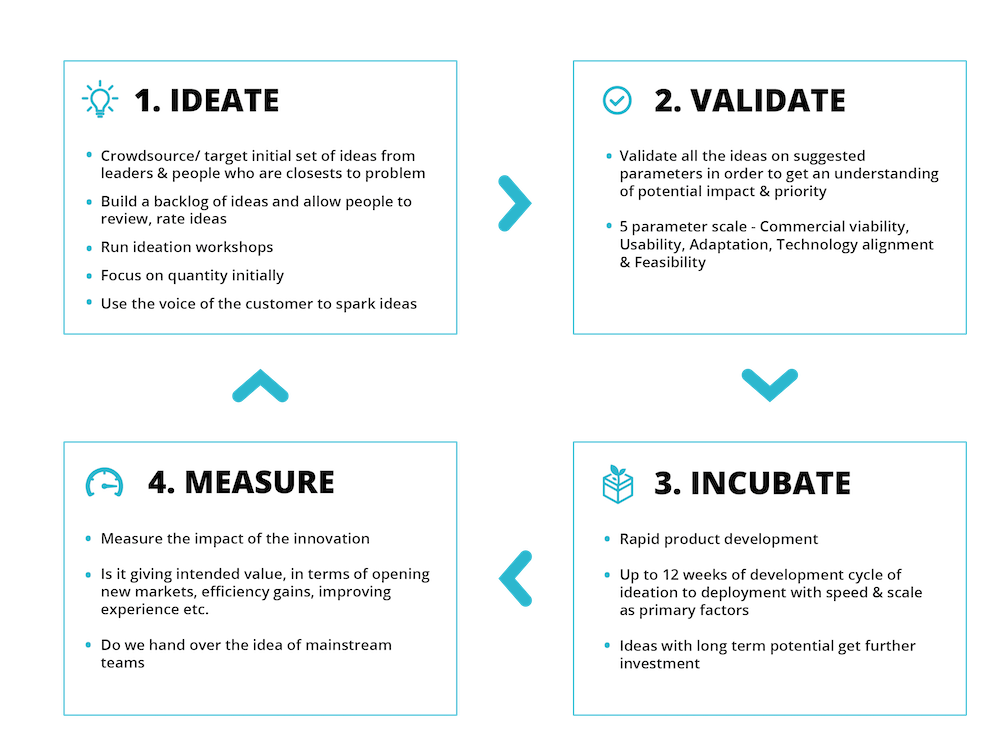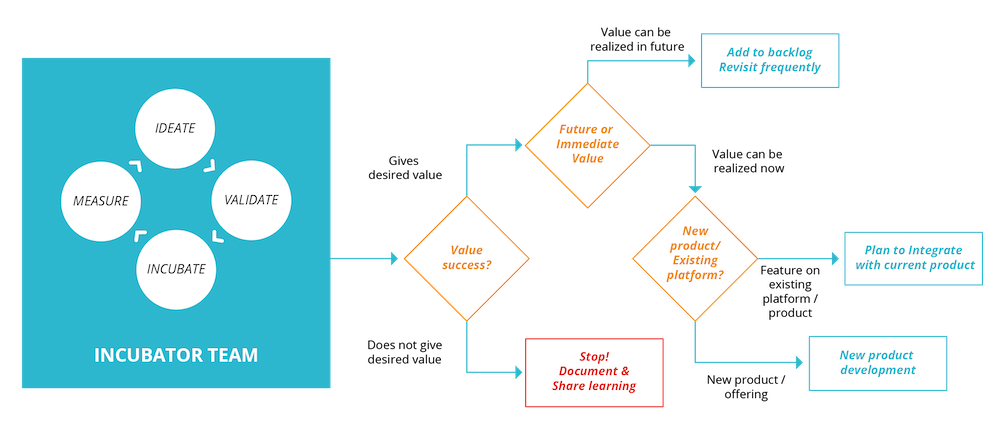Making good on ideas
This is the third part of our Impact to Innovation series. Follow the links for Part One, Part Two and Part Four.
Four phases of innovation
One of the core principles of our Innovate to Impact framework is the notion that we’re creating something that adds new value to the business. And as we’ve seen, that value might be realized in new revenue streams, new customer services or internal efficiencies. As you move through the four-stage maturity model, the goal is to build out more impactful innovations.
But as discussed, there’s little point in expecting the business to appreciate and support your efforts unless you can articulate the value derived. Validation and measurement are key. So the four stages of innovation throughout the Innovate to Impact framework can be summarized as:
- Ideate. Generate a backlog of ideas through voice of customers, crowdsourcing, hackathons, workshops. Your initial focus should be on quantity.
- Validate. Test your initial set of ideas against a defined set of parameters to understand the likely impact. Prioritize those with the biggest potential returns.
- Incubate. Build rapid prototypes, regularly showcase your work, co-create the product with your stakeholders to target value delivery
- Measure. How have you performed against expected targets? Measuring your impact.


Let’s take a look at these phases in detail.
Ideate
The purpose here is to generate ideas. Every idea is welcome as long as it’s in keeping with the theme of the task. Whether something strikes you as a flash of genius or total clanger: park your judgement for now. You want to encourage your innovation team to become an ideation powerhouse. So gather up every idea coming your way. Some form of ideation workshop can be a great way to kickstart the process.
Of course, not every idea has to be new. Your stakeholders are likely to already have their own ideas in mind, so you’ll want to ensure you involve them in the ideation process too. IT might also be necessary to do some for of discovery to identify what ideas are already out there.
Another mechanism for encouraging the flow of ideas is by using the lens of the customers’ voice. What are their pain points or their needs? What are they telling you about potential opportunities to improve your offerings?
Validate
Here, your focus is validating your pool of ideas against predefined criteria to score ideas’ potential value. This helps us prioritize and identify which ideas bring the biggest impact. The validation process forms part of what I’ve dubbed the ‘ideas funnel’. Taking a set of ideas and narrowing it down through understanding which ones will offer you the most bang for your buck.
When scoring, you may want to consider some of the following criteria:
- Commercial viability. Is the idea commercially marketable? Can it be showcased to, or used by, potential clients? Would this influence our clients or staff?
- Usability (Proof of value). Is the idea usable in the current condition and within the existing context of your organization? Is it simple and intuitive to use by people? Is it easier to deploy and maintain?
- User adaptation. How easy would it be to get first 100/1000 etc. users to adopt this? Would they find it easy to get on board? How likely are they going to be repeat users?
- Strategy alignment. Is it aligned with the organizational strategy, vision and objectives? Does it help your organization achieve its goals?
- Feasibility. How feasible the idea is to qualify as incubator idea? Is it likely to result in a large programme of work? Can it be implemented in a definite period of time? What are the considerations for costs, efforts, team etc. needed to build this?
Incubate
Once you have validated your ideas, you’ll need to move fast to deliver a product or prototype. The incubate phase is based on high-touch engagement, high-speed decisions, intrapreneurship thinking and bringing a sense of urgency into the process so that we can meet the desired outcome with speed.
To succeed here, your working team needs to be rapidly established. It should comprise of decision makers and people with domain expertise, so that they can collaborate with your incubator team.
Their first task is to dive deeper into the problem at hand while developing a shared context within the working team so that they all coalesce around desired outcomes and possible measures of success.
We advocate daily showcases to ensure everyone is aware of what’s coming up, how the solution is shaping up and what the early indicators suggest about chances of success. Changes is an integral part of incubation — you shouldn’t expect that you have the perfect solution from the get-go; but this iterative process should help you stay on track to meet your goals.
Measure
In some ways, measurements should take place at every stage of this incubation process. It’s essential to ensure you’re on the right track. But if you’re looking to create sustainable innovation within your enterprise, measurement comes into its own once you’re first solution is finished and you’re building a pipeline of ideas.
You might start by measuring what I’d describe as targeted innovation. Make qualitative assessments on your impact on the business — as well as their perception of the incubator team. This enables you to track your overall success as an innovation engine.
But you’ll also want to keep tabs on things at the initiative level. Can you show that your initiatives have saved money, time or effort? Have new market opportunities opened up? Has your organizational decision making improved? Can you demonstrate a return on investment?
Ultimately, your success as an innovation team will depend on the number of ideas that you’ve turned into long-term products. So you should plan to track this from the outset.
Always learn, always
The path towards sustainable innovation isn’t about producing the perfect solution. What matters is continuously measuring the impact of your actions and learning from that.


As the diagram above shows, what this means in practice continually revisiting your backlog of ideas. Things that may once have seemed impractical might now look urgent. Likewise, if some ideas haven’t produced the anticipated results, can you identify why not and plot a course to success? By constantly challenging yourself and your incubator team you won’t just come up with one quick win, but a sustainable program of improvements over the long term.
In Part Four of this series, we’ll take a look at how all these ideas have played out in practice.















